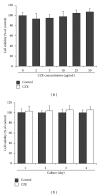Inhibitory Effect of Chrysanthemum zawadskii Herbich var. latilobum Kitamura Extract on RANKL-Induced Osteoclast Differentiation
- PMID: 24174976
- PMCID: PMC3794617
- DOI: 10.1155/2013/509482
Inhibitory Effect of Chrysanthemum zawadskii Herbich var. latilobum Kitamura Extract on RANKL-Induced Osteoclast Differentiation
Abstract
Chrysanthemum zawadskii Herbich var. latilobum Kitamura, known as "Gujulcho" in Korea, has been used in traditional medicine to treat various inflammatory diseases, including rheumatoid arthritis. However, these effects have not been tested on osteoclasts, the bone resorbing cells that regulate bone metabolism. Here, we investigated the effects of C. zawadskii Herbich var. latilobum Kitamura ethanol extract (CZE) on osteoclast differentiation induced by treatment with the receptor activator of NF- κ B ligand (RANKL). CZE inhibited osteoclast differentiation and formation in a dose-dependent manner. The inhibitory effect of CZE on osteoclastogenesis was due to the suppression of ERK activation and the ablation of RANKL-stimulated Ca(2+)-oscillation via the inactivation of PLC γ 2, followed by the inhibition of CREB activation. These inhibitory effects of CZE resulted in a significant repression of c-Fos expression and a subsequent reduction of NFATc1, a key transcription factor for osteoclast differentiation, fusion, and activation in vitro and in vivo. These results indicate that CZE negatively regulates osteoclast differentiation and may be a therapeutic candidate for the treatment of various bone diseases, such as postmenopausal osteoporosis, rheumatoid arthritis, and periodontitis.
Figures






Similar articles
-
Inhibitory Effect of Rosae Multiflorae Fructus Extracts on the Receptor Activator of NF-κB Ligand-Induced Osteoclastogenesis through Modulation of P38- and Ca2+-Mediated Nuclear Factor of Activated T-Cells Cytoplasmic 1 Expression.J Bone Metab. 2020 Feb;27(1):53-63. doi: 10.11005/jbm.2020.27.1.53. Epub 2020 Feb 29. J Bone Metab. 2020. PMID: 32190609 Free PMC article.
-
Aqueous extract of Chrysanthemum morifolium Ramat. inhibits RANKL-induced osteoclast differentiation by suppressing the c-fos/NFATc1 pathway.Arch Oral Biol. 2021 Feb;122:105029. doi: 10.1016/j.archoralbio.2020.105029. Epub 2020 Dec 31. Arch Oral Biol. 2021. PMID: 33387850
-
Pueraria lobate Inhibits RANKL-Mediated Osteoclastogenesis Via Downregulation of CREB/PGC1β/c-Fos/NFATc1 Signaling.Am J Chin Med. 2017;45(8):1725-1744. doi: 10.1142/S0192415X17500938. Epub 2017 Nov 9. Am J Chin Med. 2017. PMID: 29121799
-
Inhibition of receptor activator of nuclear factor-κB ligand- or lipopolysaccharide-induced osteoclast formation by conophylline through downregulation of CREB.Immunol Lett. 2014 Sep;161(1):31-7. doi: 10.1016/j.imlet.2014.04.006. Epub 2014 May 2. Immunol Lett. 2014. PMID: 24792671
-
Immunoregulatory properties of a crude extraction fraction rich in polysaccharide from Chrysanthemum zawadskii Herbich var. latilobum and its potential role as a vaccine adjuvant.Int Immunopharmacol. 2021 Jun;95:107513. doi: 10.1016/j.intimp.2021.107513. Epub 2021 Mar 20. Int Immunopharmacol. 2021. PMID: 33756223
Cited by
-
Ethanol extract of Chrysanthemum zawadskii inhibits the NLRP3 inflammasome by suppressing ASC oligomerization in macrophages.Exp Ther Med. 2023 Feb 7;25(3):128. doi: 10.3892/etm.2023.11827. eCollection 2023 Mar. Exp Ther Med. 2023. PMID: 36845948 Free PMC article.
-
Extracts of Chrysanthemum zawadskii attenuate oxidative damage to vascular endothelial cells caused by a highly reducing sugar.Cytotechnology. 2017 Dec;69(6):915-924. doi: 10.1007/s10616-017-0110-7. Epub 2017 Jun 12. Cytotechnology. 2017. PMID: 28608258 Free PMC article.
-
Inhibitory Effect of Rosae Multiflorae Fructus Extracts on the Receptor Activator of NF-κB Ligand-Induced Osteoclastogenesis through Modulation of P38- and Ca2+-Mediated Nuclear Factor of Activated T-Cells Cytoplasmic 1 Expression.J Bone Metab. 2020 Feb;27(1):53-63. doi: 10.11005/jbm.2020.27.1.53. Epub 2020 Feb 29. J Bone Metab. 2020. PMID: 32190609 Free PMC article.
-
Chrysanthemum zawadskii ethanol extract inhibits the replication of alpha-coronavirus and beta-coronavirus.PLoS One. 2025 Jun 18;20(6):e0326225. doi: 10.1371/journal.pone.0326225. eCollection 2025. PLoS One. 2025. PMID: 40531892 Free PMC article.
-
Dual Effect of Chrysanthemum indicum Extract to Stimulate Osteoblast Differentiation and Inhibit Osteoclast Formation and Resorption In Vitro.Evid Based Complement Alternat Med. 2014;2014:176049. doi: 10.1155/2014/176049. Epub 2014 Oct 28. Evid Based Complement Alternat Med. 2014. PMID: 25530776 Free PMC article.
References
-
- Walsh MC, Kim N, Kadono Y, et al. Osteoimmunology: interplay between the immune system and bone metabolism. Annual Review of Immunology. 2006;24:33–63. - PubMed
-
- Boyle WJ, Simonet WS, Lacey DL. Osteoclast differentiation and activation. Nature. 2003;423(6937):337–342. - PubMed
-
- Takayanagi H. Osteoimmunology: shared mechanisms and crosstalk between the immune and bone systems. Nature Reviews Immunology. 2007;7(4):292–304. - PubMed
LinkOut - more resources
Full Text Sources
Other Literature Sources
Miscellaneous

